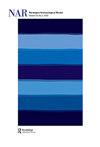颜色的物质化:重建希腊化晚期科斯的埃及蓝色制造
IF 1.1
3区 历史学
0 ARCHAEOLOGY
引用次数: 3
摘要
对比西方将色彩视为一种去物质化、抽象化的价值观,本文以爱琴海科斯岛上发现的希腊化晚期作坊为例,探讨了地中海古代的着色剂生产技术作为色彩物化的积极过程。埃及蓝生产的具有挑战性的高温工艺过程是本文的重点,旨在说明制造这种饱和蓝色颜料所需的材料转换顺序。尽管古地中海世界广泛使用埃及蓝,但只有稀少的生产遗址考古证据。Koan车间包含了一组成功和失败生产的埃及蓝色颗粒,以及无定形铅块、锂棒和地球颜料,为研究颜料的制造提供了剩余材料。在这个研讨会的背景下,制作蓝色的过程可以分为两个阶段。第一阶段包括最初的埃及蓝色颗粒的生产,第二阶段是进一步加工以产生不同色调的蓝色。本文将非物质化的色彩概念与生产的物质遗迹联系起来,使我们更接近于欣赏古老的色彩概念。本文章由计算机程序翻译,如有差异,请以英文原文为准。
The materialisation of colour: Reconstructing Egyptian blue manufacture on late Hellenistic Kos
Contrasting Western views of colour as a de-materialised, abstract value, this paper approaches the technologies of colourant production in Mediterranean antiquity as the active processes of colour materialization by examining the late Hellenistic workshop found on the Aegean Island of Kos as a case study. The challenging pyrotechnological process of Egyptian blue production is the focus of this paper, which aims to illustrate the sequence of material transformations followed to create this saturated blue pigment. Despite the widespread use of Egyptian blue in the ancient Mediterranean world, only scarce archaeological evidence of production sites exists. The Koan workshop, containing an assemblage of successfully and unsuccessfully produced Egyptian blue pellets alongside amorphous lead lumps, litharge rods, and earth pigments, provides the material remains to study the pigment’s manufacture. The process of making blue in the context of this workshop can be broken down into two phases. The first phase includes the production of the initial Egyptian blue pellets and the second the further processing for the creation of different tonalities of blue. Bridging the dematerialised notion of colour to the material remains of production, this paper brings us closer to appreciating ancient conceptualizations of colour.
求助全文
通过发布文献求助,成功后即可免费获取论文全文。
去求助
来源期刊

Norwegian Archaeological Review
ARCHAEOLOGY-
CiteScore
2.10
自引率
0.00%
发文量
13
期刊介绍:
Norwegian Archaeological Review published since 1968, aims to be an interface between archaeological research in the Nordic countries and global archaeological trends, a meeting ground for current discussion of theoretical and methodical problems on an international scientific level. The main focus is on the European area, but discussions based upon results from other parts of the world are also welcomed. The comments of specialists, along with the author"s reply, are given as an addendum to selected articles. The Journal is also receptive to uninvited opinions and comments on a wider scope of archaeological themes, e.g. articles in Norwegian Archaeological Review or other journals, monographies, conferences.
 求助内容:
求助内容: 应助结果提醒方式:
应助结果提醒方式:


